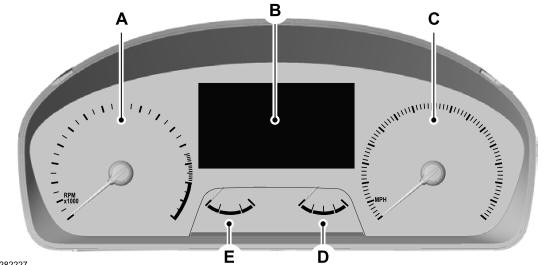Ford Explorer: Vehicle Care / Vehicle Storage
If you plan on storing your vehicle for 30 days or more, read the following maintenance recommendations to make sure your vehicle stays in good operating condition.
We engineer and test all motor vehicles and their components for reliable, regular driving. Under various conditions, long-term storage may lead to degraded engine performance or failure unless you use specific precautions to preserve engine components.
General
- Store all vehicles in a dry, ventilated place.
- Protect from sunlight, if possible.
- If vehicles are stored outside, they require regular maintenance to protect against rust and damage.
Body
- Wash your vehicle thoroughly to remove dirt, grease, oil, tar or mud from exterior surfaces, rear-wheel housing and the underside of front fenders.
- Periodically wash your vehicle if it is stored in exposed locations.
- Touch-up exposed or primed metal to prevent rust.
- Cover chrome and stainless steel parts with a thick coat of auto wax to prevent discoloration. Re-wax as necessary when you wash your vehicle.
- Lubricate all hood, door and luggage compartment hinges and latches with a light grade oil.
- Cover interior trim to prevent fading.
- Keep all rubber parts free from oil and solvents.
Engine
- Change the engine oil and filter prior to storage because used engine oil contains contaminates which may cause engine damage.
- Start the engine every 15 days for a minimum of 15 minutes. Run at fast idle with the climate controls set to defrost until the engine reaches normal operating temperature.
- With your foot on the brake, shift through all the gears while the engine is running.
- We recommend that you change the engine oil before you use your vehicle again.
Fuel system
- Fill the fuel tank with high-quality fuel until the first automatic shutoff of the fuel pump nozzle.
Cooling system
- Protect against freezing temperatures.
- When removing your vehicle from storage, check coolant fluid level. Confirm that there are no cooling system leaks and that fluid is at the recommended level.
Disconnecting Your 12 Volt Battery
- Check and recharge as necessary. Keep connections clean.
- If storing your vehicle for more than 30 days without recharging the battery, we recommend that you disconnect the battery cables to maintain battery charge for quick starting.
Note: It is necessary to reset memory features if you disconnect the battery cables.
Plugging in Your HYBRID
We recommend the following options for your plug-in vehicle (PHEV) :
- Leave your vehicle plugged in. The 12 volt battery maintains power if left plugged in. However, this periodically uses electricity from the household outlet.
- Connect a battery charger to your 12 volt battery and leave it on a continuous, slow charge.
- Disconnect the 12 volt battery. If your 12 volt battery is located in the luggage compartment, do not fully shut the luggage compartment after disconnecting the 12 volt battery. Only leave the luggage compartment open if your vehicle is stored in a locked location.
Brakes
- Make sure the brakes and parking brake release fully.
Tires
- Maintain recommended air pressure.
Miscellaneous
- Make sure all linkages, cables, levers and pins under your vehicle are covered with grease to prevent rust.
- Move vehicles at least 25 ft (7.5 m) every 15 days to lubricate working parts and prevent corrosion.
Removing Vehicle From Storage
When your vehicle is ready to come out of storage, do the following:
- Wash your vehicle to remove any dirt or grease film build-up on window surfaces.
- Check windshield wipers for any deterioration.
- Check under the hood for any foreign material that may have collected during storage such as mice or squirrel nests.
- Check the exhaust for any foreign material that may have collected during storage.
- Check tire pressures and set tire inflation per the Tire Label.
- Check brake pedal operation. Drive your vehicle 15 ft (4.5 m) back and forth to remove rust build-up.
- Check fluid levels (including coolant, oil and gas) to make sure there are no leaks, and fluids are at recommended levels.
- If you remove the battery, clean the battery cable ends and check for damage.
Contact an authorized dealer if you have any concerns or issues.
 Cleaning the Wheels
Cleaning the Wheels
Regularly clean them with a wheel cleaner. We recommend that you use Ford
approved wheel cleaner if available.
Remove dirt and brake dust with a sponge...
Other information:
Ford Explorer 2020-2026 Owners Manual: Reverse Braking Assist Precautions
WARNING: You are responsible for controlling your vehicle at all times. The system is designed to be an aid and does not relieve you of your responsibility to drive with due care and attention. Failure to follow this instruction could result in the loss of control of your vehicle, personal injury or death...
Ford Explorer 2020-2026 Service Manual: Description and Operation - Instrument Panel Cluster (IPC) - System Operation and Component Description
System Operation System Diagram - Gauges Gas Item Description 1 IPC 2 GWM 3 PCM 4 Fuel pump and sender unit 5 Base/mid-level analog gauges 6 Mid-level virtual gauges 7 AWD 8 High-level virtual gauges 9 AWD 10 AWD 11 Base level virtual gauge 12 Temperature 13 Fuel 14 S..
Categories
- Manuals Home
- 6th Generation Explorer Owners Manual
- 6th Generation Explorer Service Manual
- General Procedures - Rear Camber Adjustment
- General Procedures - Transmission Fluid Drain and Refill
- Description and Operation - Identification Codes
- New on site
- Most important about car
Gauges
4 Inch Display

A - Tachometer.
B - Information display.
C - Speedometer.
D - Fuel gauge.
E - Engine coolant temperature gauge.

